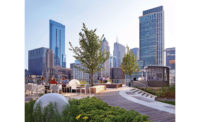The indelible images of the scorched landscapes and structures following the recent firestorms in California are causing some to reconsider the combustibility of green roofs. But clarity is emerging on that issue: effective with the 2018 edition of the International Building Code, vegetative roof systems must meet the same fire classification requirements as the roof covering and roof assembly materials.
While many architects know best practices for these roofs, those with residential clients unused to the standards may want to refresh themselves and remind clients about the green roof schemes that are not just aesthetically pleasing but also fire-rated.
Due to many variables—such as plant type, condition, depth of the growing media, and combustibility of the assembly materials—a classification of exterior fire exposure cannot be made with certainty just yet. However, choosing appropriate plants is key to safer roof design. For starters, pick plantings already evaluated for their fire-resistance, drought tolerance, and non-aggressive root systems which are less likely to penetrate and compromise underlying layers of waterproofing. Class A-rated assemblies are limited to succulent-based systems. Experts recommend at least 60% of a roof’s vegetation come from the sedum family of groundcover plantings. It is also best to avoid grasses and mosses, which can dry out and create a potential fire hazard.
Meanwhile, border zones free of vegetation can provide a fire break at rooftop equipment, penetrations, and structures. They also work to reduce the potential generation of wind-borne debris at roof perimeters and corners and provide additional resistance to high-wind pressures.
Clients should know that maintenance also plays a role in the roof’s fire-rating. Moisture levels of growing media should be checked regularly and the irrigation schedule adjusted to retain moisture and plants’ health. Weeding, fertilization, and removal of dead or dormant plants is just as important here as on the lawn, since ignoring excess biomass could inadvertently fuel a fire.





Post a comment to this article
Report Abusive Comment